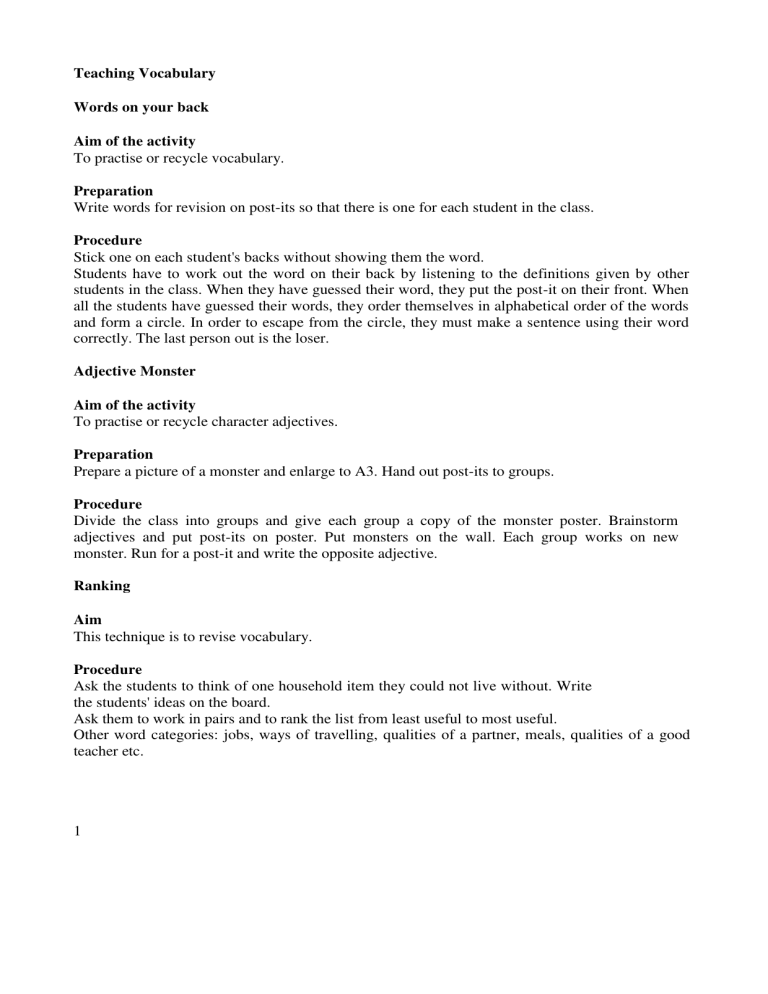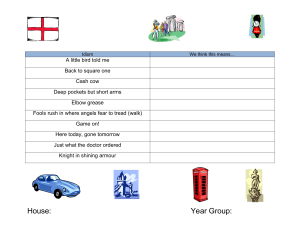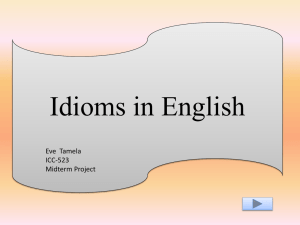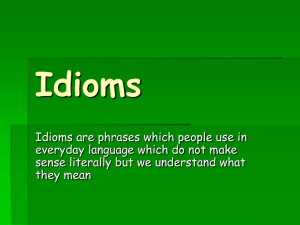
Teaching Vocabulary Words on your back Aim of the activity To practise or recycle vocabulary. Preparation Write words for revision on post-its so that there is one for each student in the class. Procedure Stick one on each student's backs without showing them the word. Students have to work out the word on their back by listening to the definitions given by other students in the class. When they have guessed their word, they put the post-it on their front. When all the students have guessed their words, they order themselves in alphabetical order of the words and form a circle. In order to escape from the circle, they must make a sentence using their word correctly. The last person out is the loser. Adjective Monster Aim of the activity To practise or recycle character adjectives. Preparation Prepare a picture of a monster and enlarge to A3. Hand out post-its to groups. Procedure Divide the class into groups and give each group a copy of the monster poster. Brainstorm adjectives and put post-its on poster. Put monsters on the wall. Each group works on new monster. Run for a post-it and write the opposite adjective. Ranking Aim This technique is to revise vocabulary. Procedure Ask the students to think of one household item they could not live without. Write the students' ideas on the board. Ask them to work in pairs and to rank the list from least useful to most useful. Other word categories: jobs, ways of travelling, qualities of a partner, meals, qualities of a good teacher etc. 1 Brainstorm activities Aim To recycle vocabulary. Procedure - Alphabet game Choose a topic category e.g. animals, parts of body, jobs, food, countries, sports etc. Go round the class and ask each student to think of one word in the category beginning with a different letter of the alphabet, in alphabetical order. If someone gets stuck, change category but start off on the letter of the alphabet the student got stuck on. - Speed game Choose a letter of the alphabet and give the students one minute to write down as many words as they can think of beginning with that letter. Students usually write nouns, but you can focus on other types of word if you like. - Adjectives Ask the students to call out adjectives and write them on the board. Encourage them to think of unusual ones. When you have got a good selection on the board, ask each student to choose • the two most useful adjectives • the two most difficult adjectives • two adjectives they like When they have done that, they should dictate their list to a partner who also writes down the opposite of those adjectives. Pairs of students discuss their different choices of words and the different possibilities for opposites depending on the context. - How many things can you think of that...? (from Five-Minute Activities by Penny Ur) Give the students a limited time to think of as many things as possible that • are bigger than they are • are smaller than they are • round, rectangular etc. • long and thin • make a noise • need electricity etc. See also "A Dictionary Game" in More Grammar Games by Mario Rinvolucri and Paul Davis -Think of a word using a letter from a TOPIC subject E.g. C OU RT R OB BER CRI ME 2 M URDER STE AL Dominoes Aim of the activity To play a matching game for revision Preparation Complete the blank domino grid, using the language your class needs to revise. Possible links are: picture + word adjective + opposite numeral + written number half a word + other half of the word half an expression + other half of the expression prefix + the rest of the word sentence with blank + the missing word a phrasal verb + its definition Students enjoy making their own dominoes. Procedure 1 - Ask the students to play the game of dominoes in groups of three to five. 2 - Give them the following instructions: a) Take 3 to 5 dominoes each (depending on the number of players) and put the rest face down in the middle of the table. b) The first player puts down any one of their dominoes face up on the table. c) The player on their left must put down a domino which matches one end of the domino already on the table. d) The players take it in turns to add dominoes in this way. If a player cannot put down one of their dominoes, they have to pick up a domino from the top of the pile in the middle of the table and put it down if they can. e) The winner is the first player to get rid of all their dominoes. Snap Aim of the activity To practise word partnerships. Preparation Prepare a set of cards. For each card there should be a matching card. For example, a bottle of + wine half an expression + the other half the word for a colour + the colour an adjective + the opposite etc 3 Procedure Ask the students to work in pairs or groups of three and explain how to play the game using the instructions below. While the students are playing, go round to each group and check they are playing correctly. HOW TO PLAY THE GAME: 1) Shuffle the cards and divide them out equally. 2) Players must hold their cards in a pile face down so that they can't see the 3) Player A puts their top card face up on the table. 4) Player B puts their top card face up on top of Player A's card. 5) If the two cards go together, the first player to shout Snap! picks up all the cards. 6) If the two cards do not go together, the next player puts a card face up on top of the pile. 7) Players continue putting down cards and should Snap! when two cards go together until they have used all their cards. 8) The first player to win all of the cards at the end of the game is the winner. Communicative crossword Aim of the activity To practise or recycle vocabulary. Preparation Make two copies of the same crossword: version A should have only the words down filled in and version B should have only the words across filled in. Make one copy of versions A and B for each pair of students in the class. Procedure Divide the class into group A and group B. Give each student in group A a copy of crossword version A and each student in group B a copy of crossword version B. Ask the students to work with a partner from the same group and to write clues for the words already filled in on their crossword. When they have done that, ask the students to find a partner from the other group and to work in pairs of A and B for the next part of the activity. It is important that students A and B do not see one another's crossword. Ask the students to sit facing their partner and take it in turns to ask one another for clues to the missing words on their own crossword. They should read out the clues they have written for their partner to guess the words, and write in the missing words on their crosswords from the clues their partner gives them. Gift words Aim of the activity To practise recently learnt vocabulary in a fun and positive way. 4 Preparation Ask the students to pick out some words they feel need reviewing from recent work and to check they know what they mean. Procedure Tell them to put the words each on a slip of paper, and to write on each slip the name of a person in the group for whom the word would be an appropriate gift. Everyone now gets up and mills around, giving the words away. If the receiver of a word does not understand it, the giver should explain the meaning, and the reason for the gift. Vocabulary Build Aim of the activity To brainstorm vocabulary. Preparation Prepare a selection of pictures to illustrate a vocabulary area you would like to brainstorm. Stick them to a larger piece of paper. For example: Food you eat in winter Food you eat on special occasions Food you eat in summer Food you don't like Get a selection of coloured pens - preferably a different colour for each group of students. Procedure Divide the students into groups of 3 or 4. Hand out a picture to each group and ask them to write as many words or expressions connected with this area of vocabulary as they can. If they don't know the word for something in English, they should draw it. Give them a coloured pen to write with. Set a time limit of a few minutes. When the time limit is up, ask them to pass their picture onto the next group. Tell each group to write as many words or expressions as possible connected with their new picture, but not including any that the previous group have written. Tell them to stop writing after a few minutes and pass their picture on to the next group. Continue this procedure until all the groups have seen all the pictures. With the class, look at each picture in turn, discussing, providing and correcting vocabulary, where necessary. Teaching Idioms Here are a few activities to help your students get to grips with the wonderful world of idioms! They are simple recycling activities aimed to consolidate the language in the 5 students’ minds. Accuracy and contextualisation are particularly important in this area of English lexis. Advertisements Ask your students to devise an advert for a product in which an idiom is included. These are then shown/displayed in the walls for other students to look at and comment on. Acting out idioms Write idioms to be practised on a separate piece of paper. A student picks one of the The pieces of paper and acts out the idiom without speaking. guess other students should try to which idiom it is. Pair Forming Write two halves of each idiom that the class has studied on separate pieces of paper and then mix them up. Hand out half an idiom to each student who then has to stand up and find his/her partner with the matching half. This can be adapted for groups. Pictionary Write the idioms to be studied on separate bits of paper. Mix them up and put them in a hat or small container. Divide the class into teams. The teacher picks out a card and then discreetly shows the idiom to the “artist” in each team. When the teacher gives a signal to begin, the “artist” in ach team has to draw a picture representing the idiom. The first team to shout out the correct one wins a point. Make sure the winning team in 100% accurate with the idiom. Making up dialogues Ask the students to create a dialogue that incorporates a few of the idioms that have been presented. Give them a time limit to write a few lines and then invite the pairs to read their dialogues aloud. Noughts and Crosses Draw a grid on the board. Ask the students to fill the nine squares of the grid with idioms that can be recycled. Divide the class into two teams. Each team chooses a square and has to make up a sentence illustrating the meaning of the idiom. If the other team agrees, then a nought (0) or a cross (X) can be put in the square. The first team to make a straight line of 3 squares is the winner. 6 Find someone who questions Make up questions that recycle the idioms you would like to practise and then ask the students to find someone who answers in a positive way. Examples of questions stems are as follows: • • • • Have you ever…? Do you…? When was the last time you…? Are you…? Conversing Write each idiom to be practised on a separate piece of paper. Ach student takes an idiom and tries to incorporate it into a natural conversation around the class. Creative stories Ask your students to brainstorm as many idioms as then y can remember and write them up on the board. Ask then to choose any 5 and in pairs or small groups, they have to create a mini story using the idioms to read out to the rest of the class. Set a time limit. Line up Write up a sentence containing an example of an idiom recently studied. Divide the sentence into 10 – 15 individual words written on separate pieces of paper. Mix the words up and give each student a card. Ask them to form a line in the order of the sentence. For example: Prince Charles put his foot in it big time last week. Students can also create their own cut-up sentences for use in class as revision or for a quick warm-up activity. You could also use the opportunity to practice the pronunciation of the idiom by getting the students with the stressed words to stand up, the students with the weak sounds to sit down and those who are linked, to link arms. This produces a really strong physical representation of the sound and rhythm of the idiom. Cartoons and pictures Try to collect as many examples or idioms as you can from newspapers, magazines, the Internet etc. If possible, scan them into your computer and use them as warmers or fillers and as a discussion point. 7 Grass Skirt Copy the Idioms Quiz from the session, or type up a list of 10 – 20 recently studied idioms in context. Slice up the handout along each divide between questions, but be careful to leave a small piece attached at one end. When finished, it should look like a grass skirt! Make one skirt for each team of 3 or 4 students. Stick the skirts around the room and make sure each team knows which skirt is theirs. Explain that one person from each team must stand up and rip ONE strand (or question) from their skirt and return to their group. The group then discusses the answer/meaning of the idiom-based question and writes it down. Another member of the team then gets the next strand, and so on, until their skirt is “finished”. This is a great activity for kinaesthetic learners and tired/bored classes. Stop the activity when the first team wins and check the answers with the whole class. 8






